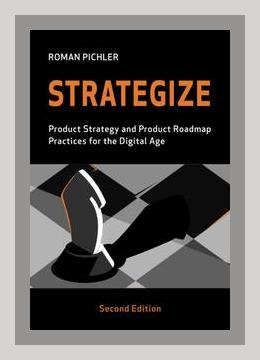Innovation and CreativityBusiness Model Innovation
Summary: “Strategize: Product Strategy and Product Roadmap Practices for the Digital Age” by Roman Pichler
Introduction
Roman Pichler’s “Strategize: Product Strategy and Product Roadmap Practices for the Digital Age” is an essential guide for anyone involved in digital product management. It effectively distills complex concepts, offering practical advice and actionable steps that help steer product strategy and roadmap activities towards success. Pichler’s insights are underpinned by clear examples and straightforward actions that can be taken immediately.
Chapter 1: Understanding Product Strategy
Key Points & Examples:
– Product Vision: This is the high-level goal that guides the development of a product. It’s critical in aligning the team’s effort.
– Example: Pichler describes a hypothetical app that helps users manage their personal finances with a product vision aiming to “improve financial literacy and management for millenials.”
– Market Research: Conducting thorough market research ensures the product meets the needs of the target customers.
– Example: Analyzing competitors and customer feedback through surveys and interviews helps in understanding market gaps.
Actions to Take:
– Develop a comprehensive product vision and share it with all stakeholders.
– Regularly conduct and update market research to stay informed about customer needs and market trends.
Chapter 2: Product Strategy Foundation
Key Points & Examples:
– Market Segmentation: Dividing the broad market into smaller, identifiable segments helps tailor products to specific customer needs.
– Example: Splitting a productivity app’s user base into segments like “freelancers”, “small business owners”, and “enterprise teams.”
– Value Propositions: Clearly defining what unique value your product brings to each segment.
– Example: For freelancers, the productivity app offers “simplified project tracking”; for enterprises, “comprehensive team management tools.”
Actions to Take:
– Create detailed profiles for each market segment.
– Develop specific value propositions tailored to meet the unique needs of each segment.
Chapter 3: Validating Product Strategy
Key Points & Examples:
– Prototyping and MVPs (Minimum Viable Products): Test ideas early with prototypes and MVPs to validate product assumptions.
– Example: Building a basic version of the financial literacy app focusing only on budget tracking to validate user interest.
– Customer Feedback: Actively seek and incorporate feedback from real users to refine the product.
– Example: Using A/B testing to determine the preferred user interface for the app.
Actions to Take:
– Develop and release MVPs to gather user data and validate product concepts.
– Establish a robust mechanism for collecting and integrating customer feedback.
Chapter 4: Defining Product Goals
Key Points & Examples:
– SMART Goals: Setting Specific, Measurable, Achievable, Relevant, and Time-bound goals that guide the team’s efforts.
– Example: A goal might be to “increase app user engagement by 20% in the next 6 months.”
– KPI (Key Performance Indicators): Identifying the right metrics to measure progress towards goals.
– Example: For the productivity app, a KPI could be “daily active users” or “task completion rate.”
Actions to Take:
– Write down goals following the SMART criteria.
– Select and regularly monitor KPIs relevant to these goals.
Chapter 5: Strategy Execution and Product Roadmaps
Key Points & Examples:
– Roadmaps: Visual documents outlining the product’s direction over time, helping align the team and stakeholders.
– Example: Creating a roadmap with milestones like “Q1: Beta Testing,” “Q2: Public Launch,” “Q4: Major Feature Release.”
– Themes and Features: Grouping related features into themes simplifies planning and prioritization.
– Example: A theme for the app could be “User Engagement” including features like notifications and gamification.
Actions to Take:
– Develop a product roadmap and update it regularly to reflect changes.
– Organize product development into themes, grouping related features to ensure coherent progress.
Chapter 6: Communicating the Product Strategy
Key Points & Examples:
– Internal Communication: Ensuring that the entire team understands the product strategy and their role in it.
– Example: Regular strategy meetings and syncs where the vision, goals, and current progress are revisited.
– Stakeholder Engagement: Maintaining transparent and regular communication with stakeholders to keep them informed and involved.
– Example: Monthly updates via reports or presentations highlighting milestones and upcoming plans.
Actions to Take:
– Schedule regular internal meetings to discuss strategy and progress.
– Create a communication plan for keeping stakeholders informed and engaged.
Chapter 7: Continuous Improvement
Key Points & Examples:
– Review and Adapt: Periodically reviewing the strategy and making necessary adjustments based on performance and market changes.
– Example: Quarterly strategy reviews to assess progress towards goals and adapt the roadmap.
– Retrospectives: Conducting retrospectives post major releases to identify areas for improvement.
– Example: Team retrospectives discussing what went well, what didn’t, and how future processes can be improved.
Actions to Take:
– Hold regular strategy and roadmap review sessions.
– Implement team retrospectives to foster continuous learning and improvement.
Conclusion
Roman Pichler’s “Strategize” offers a structured and actionable guide to defining and executing product strategies in the digital age. By applying the principles and steps from this book, product managers can ensure their products not only meet but exceed customer expectations, driving success in an ever-evolving market.
References
Pichler, R. (2016). Strategize: Product Strategy and Product Roadmap Practices for the Digital Age. Pichler Consulting.
